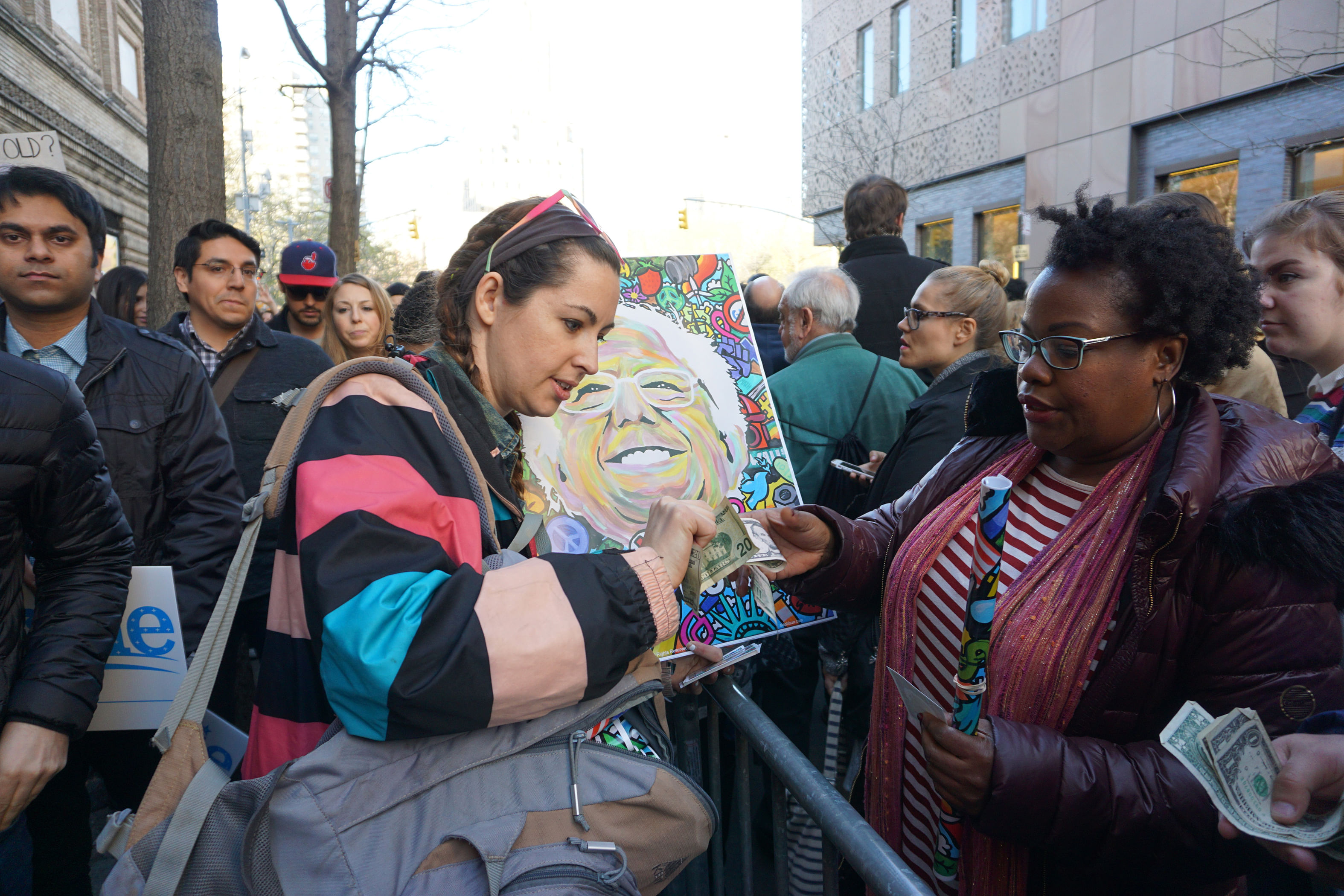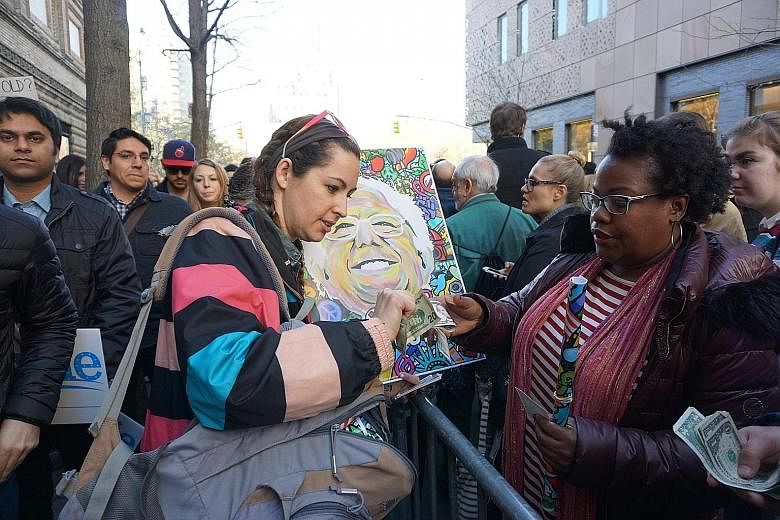WASHINGTON • Amid a sea of people at a Bernie Sanders rally in New York City in April, a striking poster of the Vermont senator looms above the crowd. Created by artist Steph Burr, 28, it has the words "our voice" in bold letters.
"He's on the right side of everything, educating people about how the political system works and the flaws in it," said the Connecticut voter, who travelled to New York - about a two-hour drive from home - just to support Mr Sanders and help raise funds through the sale of her poster.
Further uptown, on a subway platform, other supporters of the Democratic presidential candidate arranged to meet to hand out fliers to commuters.
Designer Cynthia Nguyen, 27, who organised the grassroots event and used her own resources to print the fliers, said: "Wealthy people and large corporations have too much influence in government. Bernie cares about the middle class, and we want to put out information about him so people can understand the difference between him and other candidates."
The energy from young voters working tirelessly on the ground for a candidate they believe in has no doubt changed the complexion of the ongoing primary election - through which parties choose their nominees for the November presidential polls - particularly on the Democratic side.

What was expected to be an uneventful ascension of a known entity - former secretary of state Hillary Clinton - as the Democratic nominee, turned into an unlikely battle between her and Mr Sanders, who was deemed a fringe candidate at the start of the campaign.
According to data from the Centre for Information and Research on Civic Learning and Engagement (Circle), a research centre at Tufts University, about two million young voters voted for Mr Sanders in 20 states in the primaries, compared with about 700,000 each for Mrs Clinton and Republican presumptive nominee Donald Trump.
But with Mr Sanders unlikely to clinch the Democratic nomination next month, both the Clinton and Trump campaigns know that young voters are now up for grabs, and their support could be the key to securing the White House.
THE RISE OF THE YOUTH VOTE
While young voters may have been largely ignored in the 1980s and 1990s, they have become a force to be reckoned with in the last few presidential election cycles.

Dr Kei Kawashima-Ginsberg, the director of Circle, which conducts research on the civic and political engagement of young Americans, said that in the 1980s and 1990s, Generation X - those born between 1965 and 1980 - was relatively small. But as the baby-boomer generation - born between 1946 and 1964 - had children, the millennial generation, or those born after 1980, grew, and so too did the demographic's importance.
Now, there are 49 million young people - aged 18 to 29 - who are eligible voters, compared with 45 million eligible seniors aged 65 and above. Young people also form 21 per cent of all eligible voters - around 230 million.
The common critique of young people, however, is that they do not come out to vote, but that too is beginning to change.
The uptick in youth turnout began in the early 2000s, and experts believe this had something to do with the rise of social media and people becoming more politically and civically involved through social-media-based organising.
"Those tools that are most familiar to the younger population have been a great weapon for them," said Dr Kawashima- Ginsberg.
"So unlike a few years ago, they see voting and participation in the primary as one of the levers of change, as opposed to checking out of the process."
In the last presidential election, young voter turnout was 45 per cent, compared with 66.3 per cent for those 30 and older.
So more work needs to be done to get young voters to vote, and the first step is registration.
At the recent Denver Jazz festival, staff and volunteers with non-profit group New Era Colorado hit the ground, speaking to young people and getting them to register.
"We got close to 100, which sounds small, but it was more than the last three years combined, and it really all adds up," said Ms Lizzy Stephan, 27, executive director of the group, which works to engage young people in democracy. The group hopes to register 50,000 young voters for this election cycle, and will have more than 400 staff members and volunteers fanning out across Colorado state to achieve this.
Ms Stephan said she personally got interested in the work when she was in college. A peer had encouraged her to vote in 2008, but at the same time, there were flyers around telling people that if they registered, they would be taken off their parent's health insurance, which she knew was not true, but could have been a daunting prospect for other students.
"There are people who do not want young people participating, so we have to help young people navigate the system," she said. "I think there is a lot of interest on the ground and people are getting excited earlier this year."
Another point to note is that young people today are different politically than they were in the last few decades, said Dr Kawashima- Ginsberg. Back then, they were splitting the vote 50-50 between Republicans and Democrats, so regardless of who they voted for, it didn't change the outcome.
But this changed in 2004, 2008 and 2012, when young people began leaning heavily towards Democratic candidates.
Some reasons for the shift include disillusionment with the administration of Republican President George W. Bush and a more diverse youth electorate, which believes Democrats are more likely to protect civil rights and equal access to opportunity.
The trend will probably continue this year, according to a Harvard Institute of Politics (IOP) report released in April, which showed 61 per cent of young people preferred a Democrat in the White House, compared with 33 per cent who preferred a Republican.
"They turn out at a relatively high rate, they are a big number and they vote so differently from the older electorate such that when the competition is fairly close, they can actually turn the race upside down," said Dr Kawashima-Ginsberg.
MILLENNIAL APPEAL
When Mr Sanders said on national TV early in the primary season that he was "sick and tired" of hearing about Mrs Clinton's e-mail scandal and wanted to focus on an issues-based debate, some pundits said he might have thrown away a chance to attack her credibility.
A report by the State Department Inspector General has since found that Mrs Clinton failed to follow the rules regarding her use of a private e-mail server.
But the move probably did his campaign more good than harm, especially in the eyes of young voters.
According to an analysis of national exit polls by Circle, young people are more interested in issue positions than leadership qualities, strongly prefer a candidate who they feel understands them and want a president who has a vision for change.
Mr Sanders seems to fit the bill.
During the Iowa primary in February, he also had young celebrity surrogates such as Josh Hutcherson, from the movie series The Hunger Games, and Connor Paolo, from TV series Gossip Girl, to help him along.
Spotted in Iowa State University wearing a Bernie Sanders T-shirt and encouraging students to vote, Mr Paolo told The Straits Times: "He's an authentic human being trying to achieve things such as healthcare and a better criminal justice system - things the establishment has said are just ideals."
But with the primary races almost complete, and Mrs Clinton and Mr Trump more than likely to end up on the general election ballot, many are watching to see who will inherit Mr Sanders' young supporters.
According to the Harvard IOP, among likely voters, Mrs Clinton has 61 per cent of young voters, while Trump 25 per cent, with 14 per cent still unsure of who they would pick.
While some were concerned about Mrs Clinton losing young female voters to Mr Sanders, when it comes down to Mrs Clinton versus Mr Trump, a recent CBS poll said she wins young women's votes hands down - 66 per cent to 26 per cent.
Said Dr Kelly Winfrey, an expert on women voters from Iowa State University, Mr Trump has "repeatedly attacked women in a very sexist way", and many, whether young or old, don't see his behaviour as presidential.
Considering that young women turn out at higher rates than young men, "if Clinton can keep the young female Sanders supporters engaged and get them to vote in the general election, she stands a great chance of becoming the first female president", said Dr Winfrey.
Youth community organisers say there is still a chance for candidates to win over young voters.
"If they can demonstrate, through their policies, that they understand the experience of millennials", that would help win the support of young people, said Mr Colin Seeberger, strategic campaigns adviser from Young Invincibles, an organisation which engages young Americans on issues such as healthcare, higher education and jobs.
He added that some key issues that resonate with youth include high unemployment rates, high student debts and declining wages. "These play a big role in this year's election, post the great recession," said Mr Seeberger.
But, while Mrs Clinton has been effective in addressing many of these problems, Mr Trump is the one touting the change narrative which young people are known to favour.
"He is not like others; he just says what everyone is thinking," said Mr Connor O'Neil, 22, a business executive. "This election, we don't want to see someone who is everyone's best friend. We want someone who is tough."
Dr Kawashima-Ginsberg said Mr Trump "represents that radical shift and, in some way, a sense of hope for change, in the way (current President Barack) Obama did, just from a different ideological standpoint".
But there are factors such as Mr Trump's anti-immigrant and anti-Muslim rhetoric that repel young voters.
"Kicking out certain populations" may not sit well with millennials, who are the most diverse population in the United States today, added Dr Kawashima-Ginsberg.
And when November rolls around and the electorate becomes less ideologically extreme, "it's hard to imagine young people coalescing in large numbers behind some of the concepts he is representing", said Dr Kawashima-Ginsberg.


